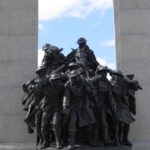The Canadian Military during the Seven Years’ War: A Comprehensive Survey
The Seven Years’ War (1756–1763), known in North America as the French and Indian War, was a global conflict that changed the course of Canadian history. The war marked the end of New France and paved the way for British dominance over North America. Canada, or New France as it was then known, was the setting for the North American theatre of this vast, imperial conflict that extended across Europe, India, Africa, and the Caribbean. In Canada, the Seven Years’ War was a contest between Britain and France, two of the world’s great colonial empires, for control of a vast and resource-rich continent. The war in Canada involved professional European soldiers, colonial militias, and Indigenous warriors, who fought in a complex, multi-front struggle for dominance. This essay explores the conditions before the war, why the war started, the reaction in New France, the mobilization of troops, the military campaigns of both French and British forces, the political dynamics of the war, and the ultimate consequences for the future of Canada.
Pre-War Conditions: New France at the Edge of Empire
In the years leading up to the outbreak of war, New France was a colony of strategic importance to the French Empire. It stretched from the St. Lawrence River to the Great Lakes, south to the Ohio Valley, and down the Mississippi River to Louisiana. The French had established strong trade networks with Indigenous peoples, centered primarily around the fur trade. New France was sparsely populated, with a population of approximately 70,000 settlers, most of whom lived in small farming communities along the St. Lawrence River.
Although the French had a vast territorial claim in North America, their ability to defend this territory was hampered by the small population and the colony’s isolation from France. Unlike the British colonies along the Atlantic coast, which had a population of over 1 million and were economically robust, New France remained dependent on shipments of food, supplies, and military reinforcements from France.
Tensions were rising on the frontier, where French and British settlers and soldiers were competing for control of the Ohio Valley, a region rich in resources and of critical strategic importance. The Indigenous peoples of the region, including the Iroquois Confederacy, Hurons, and Algonquins, had their own interests and alliances, and they played a critical role in the unfolding conflict. Both French and British authorities sought the allegiance of Indigenous nations, who were skilled in guerrilla warfare and knowledgeable of the local terrain.
Why the War Started: Imperial Ambitions and Frontier Conflict
The Seven Years’ War in North America was the result of long-standing tensions between the French and British empires, driven by their competing ambitions for territorial expansion. The immediate cause of the war was the struggle for control of the Ohio Valley, a fertile and strategically important area that both empires claimed. The French sought to link their holdings in Canada with those in Louisiana, while the British aimed to push westward and expand their colonies into the interior of the continent.
In 1754, the first shots of the war were fired when a young officer from the British colony of Virginia, George Washington, led a force of militia to confront the French at Fort Duquesne, a key French outpost in the Ohio Valley. The resulting skirmish, known as the Battle of Jumonville Glen, ended in a French victory and set the stage for a broader conflict. Washington’s defeat at the subsequent Battle of Fort Necessity escalated the conflict, drawing both Britain and France into war.
The war officially began in 1756, but the seeds of conflict had been sown years earlier. Both powers were determined to assert their dominance over North America, and the Ohio Valley became the flashpoint. For Britain, the conquest of New France was seen as a way to eliminate the French threat on the continent and secure new lands for settlement and economic exploitation. For France, New France was a key part of their colonial empire, and losing it would mean losing access to the wealth of the North American interior.
Reaction in New France: Fear and Determination
The outbreak of war was met with a sense of unease in New France. The colony’s leaders, including Governor-General Marquis de Vaudreuil and the French commander in Canada, Marquis de Montcalm, understood that their position was precarious. The population of New France was small and isolated, and the French could not rely on substantial reinforcements from France, which was embroiled in conflicts across the globe.
The French strategy in North America was to defend their territory through a network of forts and alliances with Indigenous peoples. The Troupes de la Marine, the French regular army forces stationed in New France, were supplemented by local militias, known as miliciens, and Indigenous allies. These militias were often made up of farmers and fur traders who had little formal military training but were familiar with the land and accustomed to the guerrilla-style warfare that would come to characterize much of the fighting in North America.
Indigenous allies played a crucial role in the French war effort. The French had long maintained strong relationships with the Hurons, Algonquins, and other Indigenous nations, who viewed the British expansion into the Ohio Valley as a threat to their own lands and way of life. These Indigenous warriors, skilled in hit-and-run tactics and able to navigate the dense forests and rivers of the interior, were essential to the French defense strategy.
On the British side, the reaction to the outbreak of war was marked by both fear and opportunity. The British colonies, particularly those in the north such as New York and Massachusetts, were vulnerable to attacks from French and Indigenous forces, but the colonists also saw the war as an opportunity to expand their territory and eliminate the French presence in North America once and for all.
Mobilization and Transportation of Troops: Logistics of Empire
Mobilizing troops in the vast wilderness of North America was a formidable challenge for both the French and British forces. The French had the disadvantage of being far from their homeland, and the Royal Navy controlled much of the Atlantic, making it difficult to send reinforcements. While the French did send some regular troops to New France, the colony was largely left to defend itself with local forces and Indigenous allies.
The British, on the other hand, had a more substantial logistical advantage. The Royal Navy was able to transport troops and supplies across the Atlantic, and Britain’s superior naval power allowed them to reinforce their colonial forces more effectively. Additionally, the British could rely on the substantial manpower of their colonies, raising thousands of local militia troops who supplemented the British regular army.
The British also faced the challenge of moving their forces through the rugged and often hostile terrain of North America. Rivers, lakes, and dense forests made traditional European-style warfare difficult, and the British had to adapt their tactics to the unique conditions of the North American wilderness. The French had the advantage of having established a network of forts along the St. Lawrence River, the Great Lakes, and the Mississippi Valley, which allowed them to move troops and supplies more easily within their territory.
French and British Military Participation: A Clash of Empires
The military strategies of the French and British in North America were shaped by the geography of the conflict and the resources available to each side. The French, with their smaller population and fewer regular troops, relied heavily on defensive tactics, using their network of forts and their Indigenous allies to harass British forces and prevent them from advancing into French territory. The British, with their larger population and greater access to resources, aimed to launch a series of offensives to capture key French forts and cities, ultimately leading to the conquest of New France.
The Siege of Louisbourg (1758)
One of the most important early campaigns of the war was the Siege of Louisbourg in 1758. Louisbourg, located on Cape Breton Island, was a massive fortress that guarded the entrance to the St. Lawrence River. Its capture was critical for the British, as it would allow them to launch an invasion of the heart of New France. The British, under General Jeffery Amherst and Admiral Edward Boscawen, laid siege to the fortress in June 1758.
The siege lasted for nearly two months, with the British using their superior naval firepower to bombard the fortress and cut off French supply lines. The French defenders, under Chevalier de Drucour, put up a determined resistance, but they were outnumbered and outgunned. In July, the French were forced to surrender, and the fall of Louisbourg opened the way for the British to invade the St. Lawrence River and attack Quebec City.
The Campaigns in the Ohio Valley and Great Lakes (1758–1759)
While the British were focused on Louisbourg, another front was opening in the Ohio Valley and the Great Lakes region. British forces, led by General John Forbes, launched an expedition to capture Fort Duquesne, a key French stronghold in the Ohio Valley. The French had hoped to hold the fort as a barrier to British expansion, but in November 1758, the French garrison was forced to abandon the fort in the face of overwhelming British numbers. The British renamed the fort Fort Pitt, securing their control over the Ohio Valley and cutting off French communications with their Indigenous allies.
Further to the north, the British targeted Fort Niagara, a critical French outpost that controlled access to the Great Lakes. In July 1759, British forces under Sir William Johnson besieged the fort, and after a fierce battle, the French surrendered. The fall of Fort Niagara isolated the French forces in the interior and opened the way for British advances into the heart of New France.
The Battle of the Plains of Abraham (1759)
The decisive moment of the war came in 1759 with the Battle of the Plains of Abraham, fought just outside Quebec City. The British, under the command of General James Wolfe, had spent months preparing for the assault on the capital of New France. Wolfe’s army, numbering around 7,500 troops, landed on the banks of the St. Lawrence River and began the arduous task of laying siege to the city, which was defended by General Louis-Joseph de Montcalm and his garrison of 4,500 French regulars and militia.
On the morning of September 13, 1759, Wolfe took a daring gamble. Under the cover of darkness, he led his troops up a narrow path to the Plains of Abraham, a plateau overlooking Quebec City. The French, caught off guard by the audacity of the British maneuver, rushed to meet them in battle. In the ensuing engagement, Wolfe’s disciplined British regulars overwhelmed the French forces, who were ill-prepared for the open-field combat that followed. Both Wolfe and Montcalm were mortally wounded in the battle, but the British emerged victorious.
The fall of Quebec marked the beginning of the end for New France. Although the French continued to resist for another year, the loss of their capital and the defeat at the Plains of Abraham were decisive. In 1760, the French surrendered Montreal, effectively ending their control of Canada.
The Politics of the Military Forces in Relation to the War
The Seven Years’ War was not just a military conflict; it was also a political struggle for dominance over North America. For the French, the war in Canada was only one part of a larger, global conflict. The French government, led by Louis XV, had to balance its resources between multiple theaters of war, including Europe, India, and the Caribbean. As a result, New France was often left with fewer resources and reinforcements than it needed to effectively resist the British onslaught.
For Britain, the conquest of New France was a critical war aim. The British government, under William Pitt the Elder, recognized the importance of North America as a source of wealth and power. Pitt invested heavily in the war effort, sending large numbers of troops and ships to the colonies and forging alliances with Indigenous nations. The British strategy was to overwhelm the French with superior numbers and firepower, and by 1759, that strategy was paying off.
Areas of Commitment: Campaigns Across North America
The Seven Years’ War in North America was fought on multiple fronts, from the Ohio Valley to the Great Lakes, from the St. Lawrence River to the Atlantic coast. The French and British both committed significant military resources to these campaigns, but the British had the advantage of greater manpower and naval supremacy.
The British focus was on capturing key French forts and cities, including Louisbourg, Fort Duquesne, Fort Niagara, Quebec, and Montreal. These strategic objectives were designed to cut off French supply lines, isolate their forces, and force the colony to surrender.
The French, with their smaller population and fewer regular troops, relied on a strategy of defense and harassment. They used their network of forts to slow the British advance and depended heavily on their Indigenous allies to conduct raids and guerrilla warfare. However, as the war progressed, the French found it increasingly difficult to maintain their defensive positions, and by 1760, their situation had become untenable.
Home Front Reaction to the War
In New France, the war caused significant hardship for the civilian population. The colony’s economy, already dependent on the fur trade and agriculture, was severely disrupted by the war. Farmers along the St. Lawrence River were often forced to provide food and supplies to the French military, leaving little for themselves. As British forces advanced, many settlers fled their homes, seeking refuge in Quebec City or Montreal.
In the British colonies, the war was seen as both a threat and an opportunity. Frontier settlers lived in constant fear of French and Indigenous raids, but the prospect of expanding British territory and eliminating the French threat was a powerful motivator. The war also placed significant financial strain on the colonies, as they were required to raise militia forces and contribute to the war effort.
Development of the Armies: Lessons from War
The Seven Years’ War marked a turning point in the development of both the French and British military forces in North America. The war highlighted the importance of naval power, logistics, and the ability to adapt to the unique conditions of the North American wilderness.
For the French, the war exposed the limitations of their colonial military system. While the Troupes de la Marine and local militias were effective in small-scale skirmishes and defensive operations, they were no match for the larger, better-equipped British forces in open battle. The reliance on Indigenous allies, while initially a strength, became a weakness as the war progressed, and many Indigenous nations, seeing the tide of war turning, shifted their allegiances to the British.
For the British, the war was a proving ground for the colonial militias, who played a significant role in the conflict alongside the regular army. The war also demonstrated the importance of coordination between naval and land forces, as the success of campaigns like the siege of Louisbourg depended on the Royal Navy’s ability to cut off French supply lines and support ground operations.
Conclusion: The Fall of New France and the Legacy of the Seven Years’ War
The Treaty of Paris, signed in 1763, brought an end to the Seven Years’ War and marked the official transfer of New France to British control. The war had been long and costly, but for Britain, the victory was decisive. With the conquest of Canada, Britain became the dominant power in North America, setting the stage for the future development of Canada as a British colony.
For France, the loss of New France was a devastating blow. The war had drained the French treasury, and the loss of its North American empire weakened France’s position on the global stage. For the Indigenous peoples of the region, the end of the war marked the beginning of a new and difficult chapter, as British expansion into their lands would bring new challenges and conflicts.
The Seven Years’ War reshaped the map of North America and laid the foundation for the future of Canada. It was a conflict that tested the military capabilities of both the French and British empires and highlighted the critical role of Indigenous alliances in the struggle for control of the continent. The war’s legacy would continue to shape Canada’s history for generations to come.



